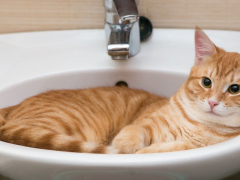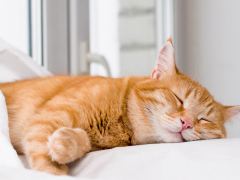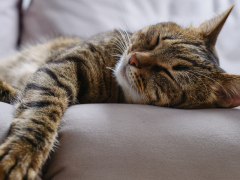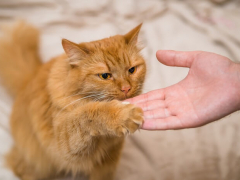
Melina Grin / Cats.com
Bringing multiple cats into the same household can be rewarding but also challenging. While some cats may form strong bonds, others struggle with territorial disputes, resource guarding, and social hierarchy conflicts. If your cats frequently hiss, swat, or chase each other, addressing these behaviors early is essential to prevent long-term stress.
Key Takeaways
Identify the root cause: Conflict often arises from territory disputes, resource competition, or lack of previous socialization.
Provide multiple essential resources: Ensure each cat has its own food bowl, litter box, perch, and safe resting space.
Use gradual introductions and scent swapping: Slow, controlled staged interactions can help cats form positive associations.
Understanding why cats fight and implementing practical solutions can create a peaceful, stress-free environment for your feline companions in a multi-cat home.
Common Causes of Cat Conflict
Not all cat conflicts stem from aggression—some arise from miscommunication or triggers of stress. Below are key reasons why cats may not get along:
- Territorial behavior: Cats are naturally territorial and may feel threatened by a new cat in their space which can be perceived as limiting their access to food and territory.
- Resource guarding: Cats may compete for food, water, litter boxes, favorite resting spots, or even the cat flap, which gives access to the outdoors.
- Social hierarchy disputes: A social order must be established in multi-cat households. Some cats are naturally more confident than others.
- Personality mismatches: A high-energy cat may overwhelm a more reserved cat, leading to tension. Significant age gaps can also be problematic for this reason.
- Past negative experiences: Cats with a history of trauma or previous fights with other cats, even down to a particular color or gender, may react defensively.
- The size of the home in terms of the space allowed. A smaller house with too many cats will cause conflict, as each cat will not be able to have its own safe space. So, just because you want another cat, ask yourself if you have the space and resources to support their best welfare.
Understanding these potential triggers allows cat parents to effectively tailor their approach to resolving conflicts when tensions arise in the home and appreciate that relationships in a multi-cat home are transient and may wax and wane both positively and negatively.
10 Effective Ways to Reduce Conflict Between Cats

Melina Grin / Cats.com
1. Gradual Introductions Matter
Never force immediate visual contact if you’re bringing a new cat home. Instead, introduce their scents first. Swap bedding or use a clean sock to rub each cat’s scent on shared objects. Let them sniff each other through a closed door before gradually allowing visual introductions with a safety barrier, such as stacked baby gates or a dog mesh gate. When this is going well, you may move on to supervised meetings.
2. Maintain Separate Resources
Conflicts often arise when cats feel they must compete for basic welfare needs. To avoid confrontation, place food bowls, litter boxes, and resting areas in separate locations and follow the “one per cat, plus one extra” rule. This reduces tension as resources are in abundance. Even fully bonded cats should always be fed separately to reduce tensions.
3. Provide Vertical Space
Cats feel more secure when they can retreat to high places, like cat trees or wall-mounted shelves. This helps less confident cats avoid confrontation while giving more confident cats a sense of control. Cats are prey, too; the high resting places make them feel less anxious and safe.
4. Use Pheromone Diffusers
Plug-in devices that contain synthetic pheromones to mimic the cats’ own facial pheromones. The cats rub these in their territory along door frames, corners of walls, etc. These provide calming signals that help a cat feel safe and secure in its territory and, therefore, help to reduce tension. Placing diffusers in shared spaces can create a more relaxed atmosphere. Blended soporific cat attractants such as blended valerian, vetiver, and clary sage also have a calming effect on cats in the home when used as plug-in diffusers or sprays. Avoid catnip in a multi-cat home with conflict, as this is a stimulant and will only increase tensions.
5. Monitor Body Language

Melina Grin / Cats.com
Learning the subtle cat-to-cat communication signs can help prevent conflicts from escalating. The majority of cat communication is non-verbal and may go unnoticed. Common warning signs include:
- Flattened ears
- Muzzle tension
- Hard staring
- Dilated pupils
- Tail flicking
- Puffed-up fur(Pilo erection)
If you notice these signals, calmly separate or distract the cats before a fight or negative encounter ensues.
6. Provide Adequate Play and Stimulation
Boredom can lead to redirected aggression. Engaging your cats with interactive play sessions mimics hunting behavior and reduces stress. Wand toys, puzzle feeders, and scheduled playtime keep them mentally and physically stimulated. Engage in solo and parallel play with your cats so that the less confident cat also has a chance to have fun.
7. Avoid Punishment
Yelling or using a spray bottle may stop a fight temporarily but can worsen the conflict in the long run as the cat will associate the negative punisher with the one with which it is having conflict. Instead, use positive reinforcement by rewarding calm behavior with treats and praise.
8. Implement a “Time-Out” Strategy
If fights occur, temporarily separate the cats into different rooms with a distraction such as cat TV or calming music. Allowing them to cool down before reintroducing them in a neutral space. This helps prevent lingering tension.
9. Reinforce Positive Interactions
When cats display friendly behaviors—such as nose-touching, grooming, or relaxed body language—reward them with treats, verbal praise, and affection. Over time, they will associate each other’s presence with positive experiences.
10. Consider Professional Help If Needed
If conflicts persist despite your best interventions, consult a feline behaviorist or veterinarian before things escalate. Intervention sooner rather than later can reduce the time it takes to remedy the dynamic. Underlying medical conditions, such as pain or anxiety, can contribute to aggression and should be ruled out as behavioral and pathogenic symptoms can co-exist.
Final Thoughts

Melina Grin / Cats.com
Cat conflicts are common in multi-cat households, but they can be managed with proper introductions, resource allocation, and positive reinforcement. Every cat has a unique personality, and understanding their needs can help reduce tension and create a harmonious home. Do you have adequate living space and the time to devote to each cat individually to support their mental and physical needs?
If fights or tensions persist despite interventions, consider consulting a feline behaviorist or veterinarian to rule out medical or anxiety-related causes.
-
Bradshaw, J. W. S. (2013). Cat Sense: How the New Feline Science Can Make You a Better Friend to Your Pet. Basic Books.
-
Overall, K. (2013). Manual of Clinical Behavioral Medicine for Dogs and Cats. Elsevier.
-
Crowell-Davis, S. L., Curtis, T. M., & Knowles, R. J. (2004). Social organization in the cat: A modern understanding. Journal of Feline Medicine & Surgery, 6(1), 19-28.
-
Mills, D. S., & Hall, S. S. (2014). Animal-assisted interventions: Guidelines for the use of therapy animals. Frontiers in Veterinary Science, 1, 1-9.








[Corrected Version]
This is an exceptional article and, as a Dr myself, I say this very rarely! The author should be commended. I wish I’d had this much information 20 years ago. I already had a multi-cat home of rescues, and had done successful, gradual cat introductions, but this much info was not available then. When I married, my husband’s cat had to be introduced to my three cats who were happy together and accepting of newcomers. His cat, however, was not. Even though I did a month-long gradual introduction, she simply would not accept anyone or integrate. None of my three were aggressive toward her in any way, but she simply could not accept anyone else sharing the same space. My husband was so distraught that he actually suggested giving her away. I, however, could and would not allow that. I told him that just because you have a problem child doesn’t mean you get rid of that child. So we kept her even though she never integrated with the others. We had a somewhat stressful home, but thank God there was never a physical altercation between them or any urine marking. The furthest it went was that she would flatten her ears and hiss at the others. We did use pheromone diffusers, but at that time additional information simply did not exist. I wish we had known this much more back then. Understanding animal behaviour has come a very long way! Thank you so much Ms Campion, from the bottom of my heart.
This is an exceptional article and, as a Dr myself, I say this very rarely! The author should be commended. I wish I’d had this much information 20 years ago. I already had a multi-cat home of rescues, and had done successful, gradual cat introductions, but this much info was not available then. When I married, my husband’s cat had to be introduced to my three cats who were happy together and accepting of newcomers. His cat, however, was not. Even though I did a month-long gradual introduction, she simply would not accept anyone or integrate. None of my three were aggressive toward her in any way, but simply could not accept anyone else sharing the same space. My husband was so distraught that he actually suggested giving her away. I, however, could and would not allow that. I told him that just because you have a problem child doesn’t mean you get rid of that child. So we kept her even though she never integrated with the others. We had a somewhat stressful home, but thank God there was never a physical altercation between them or any urine marking. The furthest it went was that she would flatten her ears and hiss at the others. We did use pheromone diffusers, but at that time additional information simply did not exist. I wish we had known this much more back then. Understanding animal behaviour has come a very long way! Thank you so much Ms Campion, from the bottom of my heart.